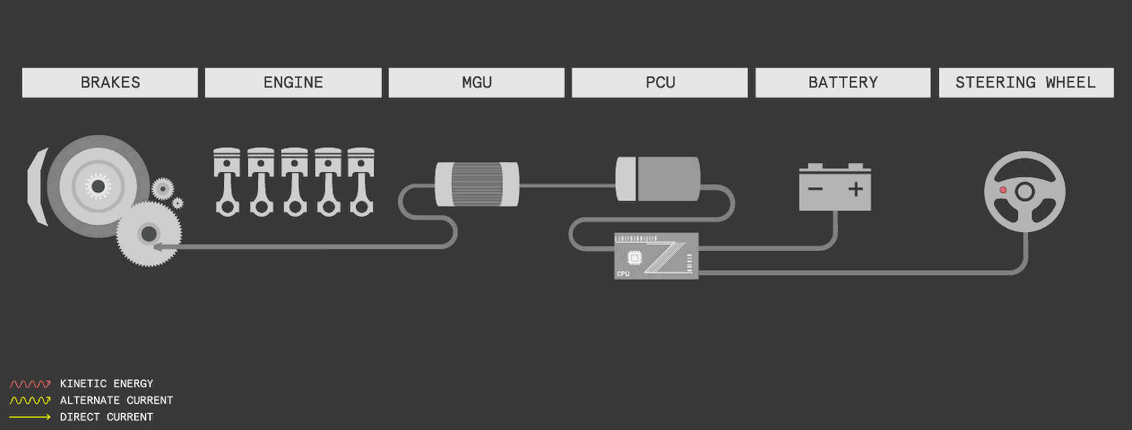It seems that the crazy automobile techs we only used to see in sci-fi films could actually be our future reality, thanks to Formula 1 (F1). The innovations in this motorsport are said to be supercharging the world – introducing new technological applications year after year in the quest for that ultimate speed.
F1 racing is way more than setting speed records, though. For years since its first-ever race, motorsport has been supercharging the world – paving a brand new way for bigger opportunities and a more modernized approach to speed machines.
The rate at which tech innovations in F1 spring forth is a positive indication that there is no limit to what passion and genius can do when joined together. Here are some technologies used in F1 racing cars.
KINETIC ENERGY RECOVERY SYSTEM (KERS)
This technology allows F1 cars to recapture kinetic energy given off during stopping or slowing down when hitting the brakes and storing it in some reservoir like an ultracapacitor and/or a flywheel that can be used to power other mechanisms in the car.
In the 2009 Formula One Season, KERS was officially introduced and was allowed by FIA. It allowed drivers to recover up to 60kW of kinetic energy and convert it to either mechanical or electrical energy instead of heat, which drivers can effectively utilize for about 6-8 seconds, ultimately creating a hybrid race machine.
HANS Device
One of the best applications of technology not only in F1 but also across the realm of motorsports is the mandatory use of the Hand and Neck Support device (HANS). This device acts as a head restraint that secures the helmet to the driver’s body.
Motor racing as an extreme sport entails bigger risks than others, and drivers always raced through tracks with uncertainty. Given the many casualties in the field of motorsports, engineers found a way to lessen the impact of accidents should they happen, if not completely avoid it. HANS’s U-shaped collar protects the head from possible injuries caused by the impact.
Read more: Top 10 Greatest Formula 1 Race Drivers in the U.S. History.
THE J-DAMPER INERTER
This inerter was first nicknamed by McLaren as ‘J-Damper’ in a ploy to keep the technology hidden from other manufacturers as long as they can. This tech allows the car to have much more grip and stability whilst accelerating as it reacts to the acceleration of the suspension, absorbing the loads fed into the chassis, which other velocity-sensitive conventional dampers can’t control otherwise.
The ‘J’ stands for ‘jounce’ (from the words jump and bounce), hinting at the techs ability to oppose the up-and-down vibrations, improving grip and making the steering much easier.
ACTIVE SUSPENSION
Before being banned after its last usage in 1993, the active suspension is a computer-controlled system that allowed the team to optimize their ride height’s configuration along with other variables allowing for the more extreme design of aerodynamic systems and stabilizing the mechanical grip.
The active suspension system measures the downward pressure on the tire. Based on that information, it optimally stiffens and/or softens the active springs on each corner, which lets the driver control the downward pressure on each tire, giving them a stronger grip on the surface.
MONOCOQUE CHASSIS
F1 will be forever in gratitude to the Lotus team boss/designer Colin Chapman, the inventor of the monocoque. Basically, a monocoque is that single piece of material that does all the heavy lifting and provides structural strength and support. First used in a Lotus 25 in 1962, monocoques were introduced to the F1 racing with aluminum as the preferred material, improving the car’s strength and rigidity and minimizing its overall weight.
Today, monocoques mainly feature carbon fiber woven into the entire chassis, making it almost indestructible: guaranteeing the driver’s safety and greatly minimizing the chance of having casualties.
DRAG REDUCTION SYSTEM
F1 cars’ aerodynamic components needed a smooth airflow for it to effectively utilize the downforce and aero balance its design is expected to generate. A drag reduction system (DRS) allows the car to achieve this and eliminate, as much as possible, the ‘dirty air’ or that force coming off the other vehicles in front of a car.
This system lets the drivers actively adjust the car’s rear wing angle to help reduce the drag force and give chasing competitors a fighting chance against the leading one.


